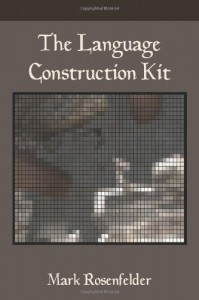 I've enjoyed following his website for a couple or three years now - http://www.zompist.com/ - and I downloaded/printed the original (much shorter) version of this to aid me in my own conlang forays.
I've enjoyed following his website for a couple or three years now - http://www.zompist.com/ - and I downloaded/printed the original (much shorter) version of this to aid me in my own conlang forays.___________________________________________________________
Review will follow as soon as I polish my conlang sufficiently.
___________________________________________________________
I may have mentioned in passing in other reviews that some of my favorite parts in The Lord of the Rings and The Silmarillion are the appendices where Tolkien writes about the languages of Middle Earth. As a boy, I would pore over the notes on pronunciation and the index of names, making up words and names for my own use in my own imaginary worlds. Now, my older self has most of Christopher Tolkien’s volumes of his father’s notes, which include the only extensive essay Tolkien pere ever wrote on any of his invented tongues – “Lowdham’s Report on the Adunaic Language,” Sauron Defeated: The History of The Lord of the Rings, Part Four. My older self is thrilled as well that Al Gore invented the Internet because I discovered there the hominin species homo sapiens geekus conlangis - the community of men and women who spend far too much of their free time making up imaginary languages comprising all the elements of the real things.
Mark Rosenfelder’s Language Construction Kit is an Idiot’s Guide to making those imaginary languages.
Part of the audience is the gaming community, particularly those gamemasters who want to create worlds that sound realistic. To that end, Rosenfelder gives some rough-and-ready guidelines for creating word lists and affixes that can be used to make names and short sentences for role-playing purposes. The second half of the book’s audience is the hardcore conlanger who may or may not be creating a language for any reason beyond the pure pleasure of the exercise. For those, he has chapters on sounds, vocabularies, grammar, semantics, pragmatics, language families and writing systems, and an appendix where he presents one of his own invented languages, Kebreni.
I wouldn’t recommend this book for the “casual” conlanger. Not because it wouldn’t be useful but because the author has had a shorter version on his website* for several years and that’s sufficient for someone who wants to avoid the dungeon-exploring party made up of “Boris,” “Bear Who Hates Honey,” “Wanda” and “Presto the Magician” adventuring in “Angland.”
Hardcore conlangers (especially those who are just beginning) should find a wealth of useful information and tips on making their languages more than just English with different words, however. Rosenfelder assumes the reader has a fair knowledge of linguistics but provides a useful bibliography for people who want to catch up. There is one thing that would have made the book better, IMO, and that is a CD with examples of pronunciations. It’s all well and good to describe tongue positions, breathing, and the difference between a high and a low vowel but I have trouble “hearing” them. After years of reading various grammars and linguistics texts, I still can’t easily identify alveolars from alveolar palatals or an affricative from a fricative.
For several years now, I’ve been putzing around with my own conlang, meleke, born as part of an imaginary world originally created for my Dungeons & Dragons buddies back in the day. I have a fairly extensive wordlist and grammar notes but I’ve always had trouble finding a verb system I like. However, under the pressure of writing this review, I have managed to create one that I mostly like and have used it to translate the quintessential translation text for all “serious” conlangers – the Babel Text from Genesis 11:1-9:
Lemmonas osura tanda mava set tulonas tamenna aidar maknar. Rhojir tar si ratha, dennonas khellen shada si han SHINAR, kepsonas tamenna not. Afentonas intar tamenna – Fenathat menna tarmen set sajathat forsai menna disa. Tulonas tamenna nar amnen tarmen set nar bratho tumo. Tisona LORD aprir eserva set ostoro set arthir khellen khoten. Afentona tamen – Sathas tamenna sot. Soterathas tamenna lammas mava sot tanda mava fir nanta. Noyen faffas tamenna shenta ursa. Afentona tamen – Ismaffat set allanaffat tandar taralle. Uprathas tamenna kel afentir intar tamenna. Gatrona LORD atarat alo tar. Duronas arthir tamenna esevra. Apellonas khellen esevra BABEL preset not kadhir LORD glavo tandave alove. Gatrona LORD kar not atarat alo tar.
(Taken from The New English Bible with the Apocrypha: Oxford Study Edition version of The Bible)
It’s still pretty rough – I haven’t developed the language enough to fully capture subtle connotations – and I’m still not entirely happy with the verbs but overall I think it’s coming along nicely. My problem is that I don’t have the patience to stick with it for extended lengths of time; I fiddle around with it for an hour one day, come back a week later, and then let it lay fallow for a few weeks.
But back to the book – This is definitely a highly specialized niche read. If you are a conlanger, I say, “check it out”; if you’re not, shake your head in bemusement, if you must, but devote your reading time to something else.
* The website contains a whole bunch of fascinating articles and not solely anent conlangs. I have especially enjoyed his essays on Asimov's "psychohistory" and his reviews of the entire Foundation series, including the non-Asimovian, and best IMO, Psychohistorical Crisis.


